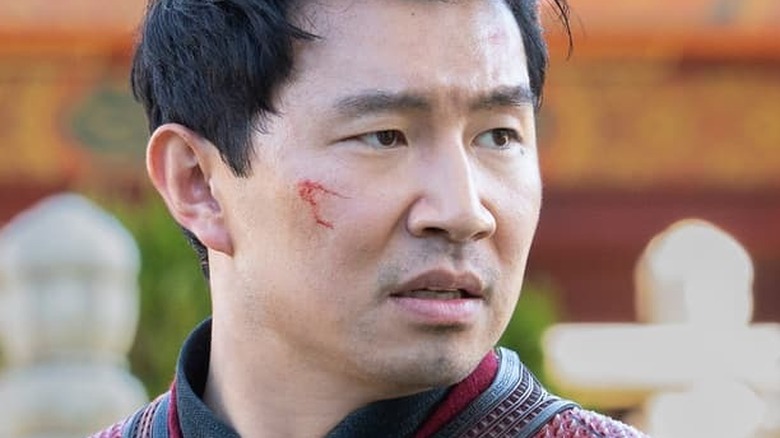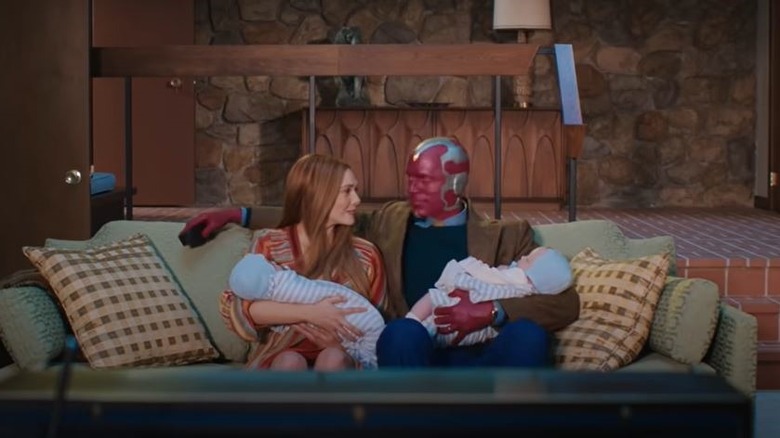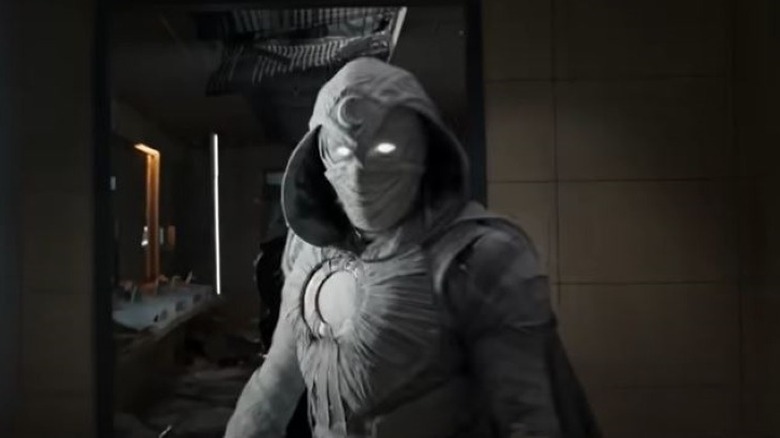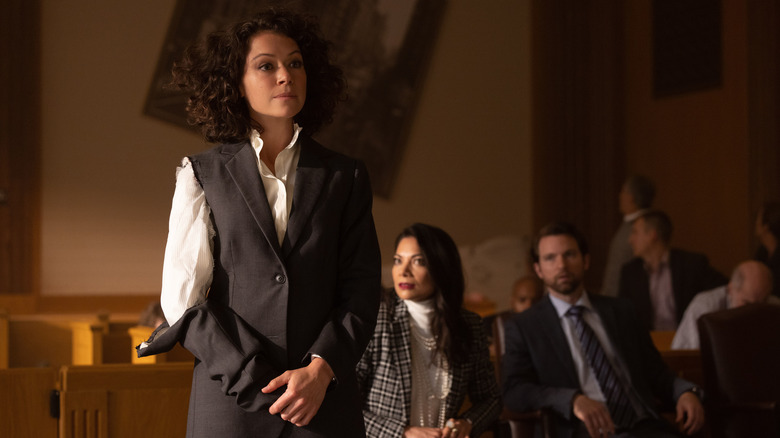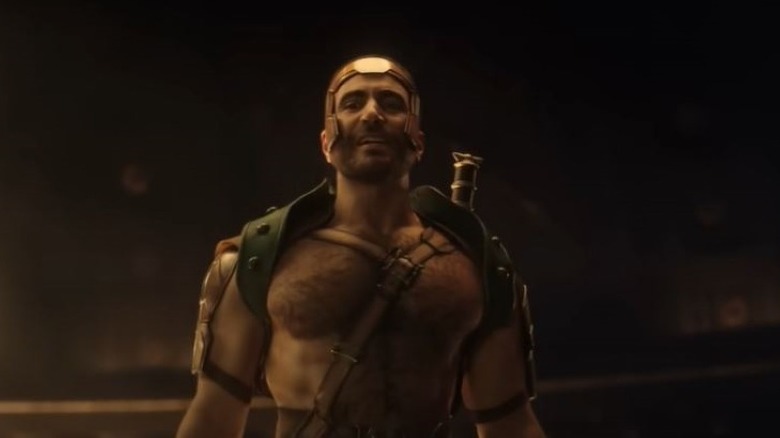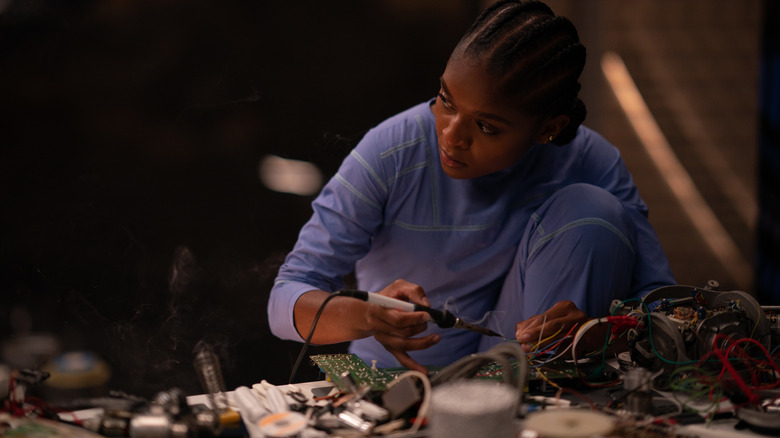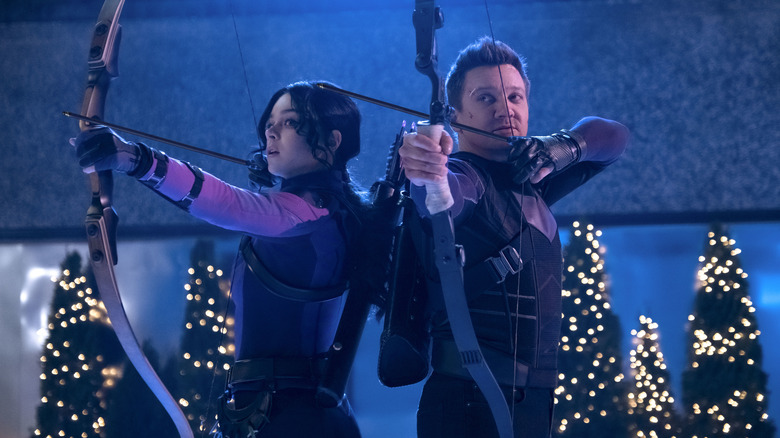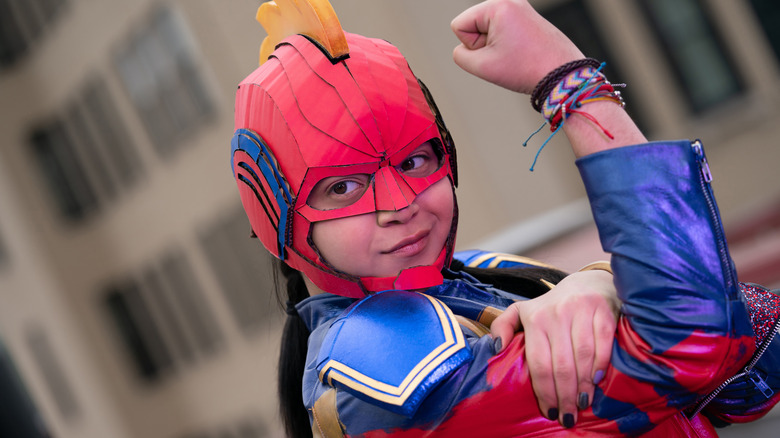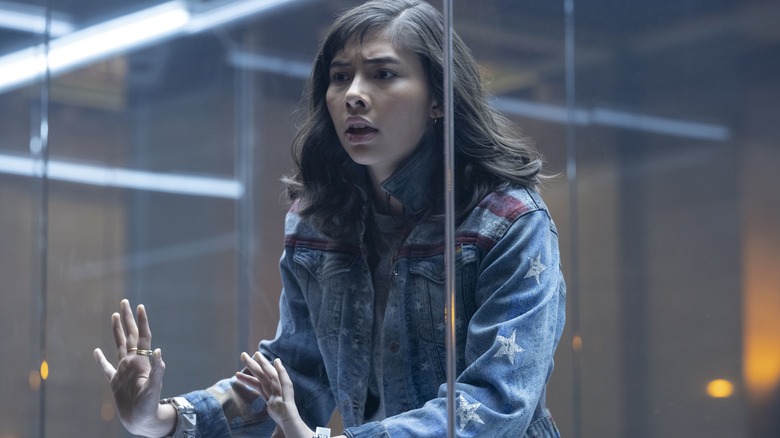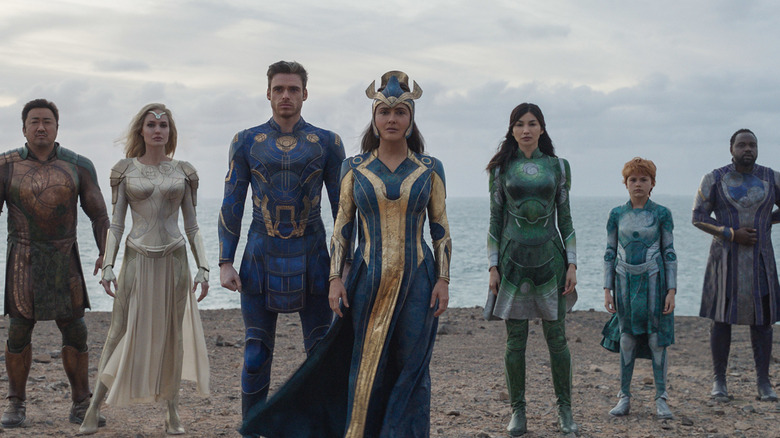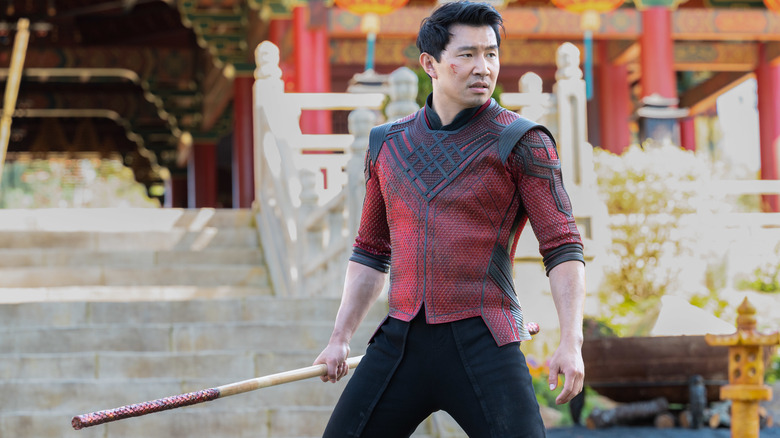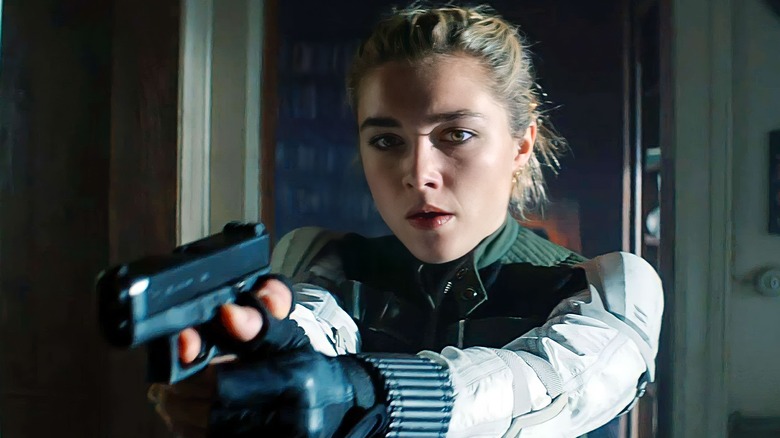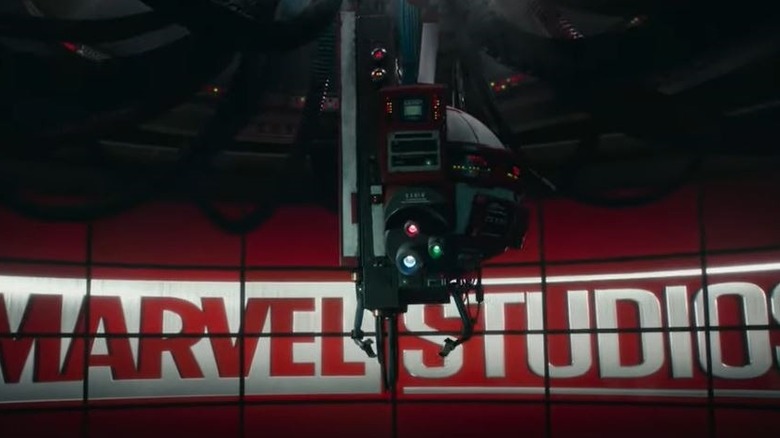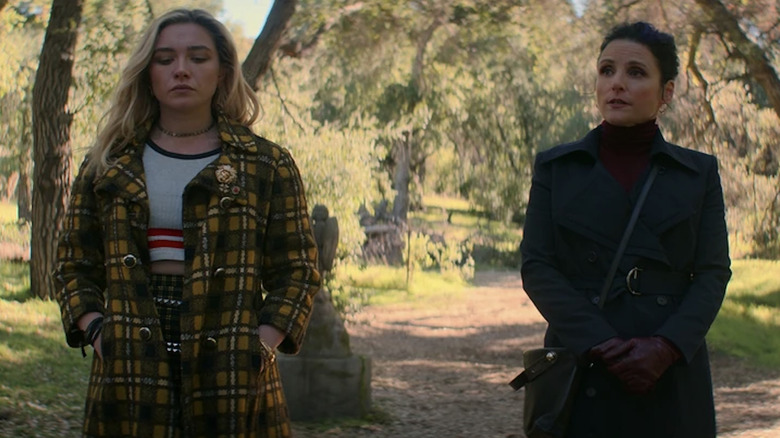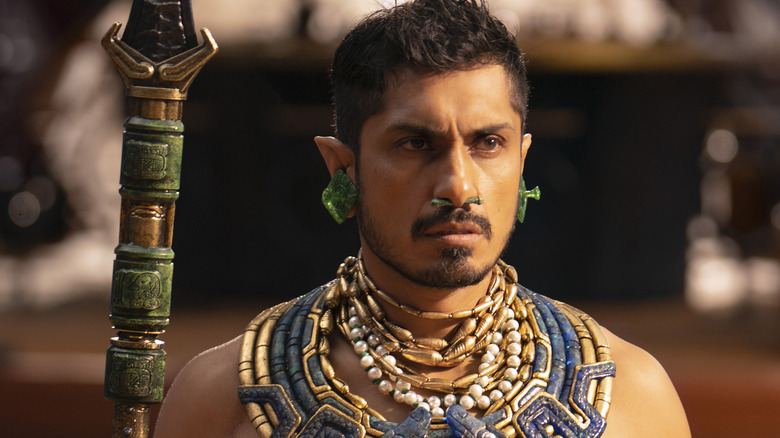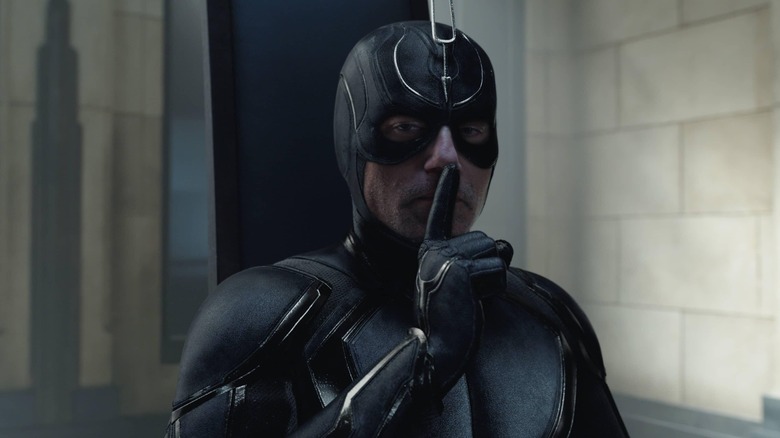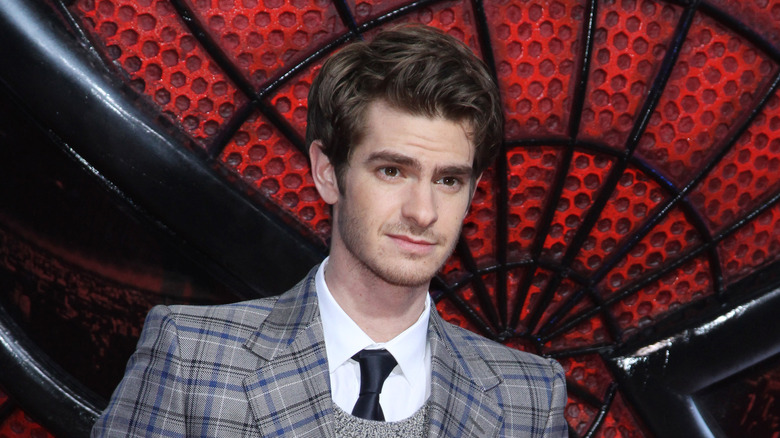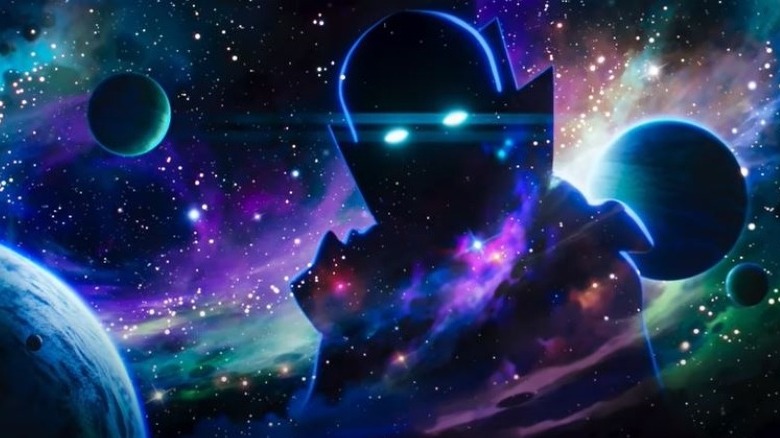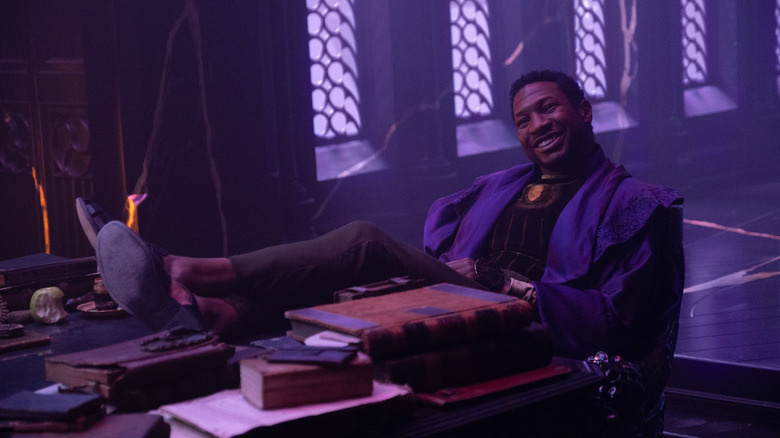The Most Important MCU Characters Introduced In Phase 4
According to Marvel, the December 2022 release of the "Guardians of the Galaxy Holiday Special" marked an end to Phase Four of the Marvel Cinematic Universe. After the third phase of the increasingly-complex series of films and TV projects wrapped in 2019, the goal for Phase Four seemed to be a tough one: Move beyond the recently triumphant (and retired, dead, and/or aging) Avengers and reset the pins.
Rebuilding and retooling the universe was a necessity after "Avengers: Endgame," the culmination of 22 unique full-length features. Now, fans wondered, who would be the next heroes to captivate attention the way Cap, Iron-Man and Thor did when they first exploded onto movie screens?
Looking back now, there are plenty of ongoing debates about the quality of MCU's Phase Four, but this much is hard to debate: Marvel swung for the fences. Aside from introducing audiences to themes like the multiverse and variants, the MCU broke away from exclusively producing full-length films. The arrival of "WandaVision" kicked off a constant stream of Disney+ live-action shows, "What If...?" folded animation into the cinematic franchise, and a pair of television special presentations at the end of 2022 added another method of entertainment to Marvel's growing repertoire. From Eternals to zombies, Ms. Marvel to Moon Knight, Shang-Chi to She-Hulk, the MCU is now more expansive, more genre-flexible, and more diverse than ever before.
Let's look back on the most significant names added in Phase Four — and how they're likely to impact the MCU as Phase Five kicks into high gear.
Billy and Tommy Maximoff
The earliest new superheroes introduced in Phase Four, Billy and Tommy Maximoff are the twin children of Wanda and Vision during the early scenes of "WandaVison," released in January 2021. The Disney+ series explored how Billy and Tommy were manifested by their mother's mystical powers — whether they are real or not is left up to interpretation. However, Wanda's motherly connection to the twin boys would be potent enough for her to wreak havoc across parallel realities in "Doctor Strange in the Multiverse of Madness."
Keen-eyed comic book readers are quick to point out the value of Billy and Tommy Maximoff in the live-action Marvel films. The twins' uncertain existence was equally destructive in the source material, a part of their mother's literary breakdown that caused her to banish all mutants from reality in the 2005 comic event "House of M." Alternatively, young Billy and Tommy grow up in the books, becoming superhero members of the Young Avengers, dubbed Wiccan and Speed. With powers emulating Wanda and her brother Quicksilver, the twins become part of a younger generation of heroes, and significant pieces in battling the Skrulls' "Secret Invasion" of Earth.
Moon Knight
Another superhero introduced as part of the MCU's all-new lineup of Disney+ shows, the 2022 "Moon Knight" series presented a darker, street-level character tied to his own ancient mythology. A trippy, "12 Monkeys"-like labyrinth of a series, it sometimes divided fans — but nevertheless, showed potential for the character's expansion beyond the miniseries, one Oscar Isaac seems eager to pursue.
A Marvel Comics character since 1975's issue #32 of "Werewolf by Night," Isaac's take on Marc Spector shook things up considerably, moving the Knight beyond age-old gripes of serving as Marvel's answer to Batman. There was a significant tease offered at the end of Season One, and there seems to be plenty of room for further exploration.
While the character's future in the live-action franchise is unknown, he ranks among the most likely Phase Four heroes who'll play a significant role moving forward — and not just because he's played by one of Hollywood's most in-demand actors. Recently, series head writer Jeremy Slate said in an interview with Inverse that a Season Two is likely and "this guy's story is definitely not done."
She-Hulk
It's hard to imagine a character (and performance) more different than Oscar Isaac's Moon Knight and Tatiana Maslany's "She-Hulk," but the fact that both could co-exist in the same universe shows how expansive (and complex) the MCU is becoming. Could they ever team up? It would feel as much like a battle of tone as it would involving their superpowers.
Nevertheless, "She-Hulk: Attorney at Law" launched with a nine-part first season that offered new faces to Jennifer Walters' developing story as a superhero lawyer. A few of the memorable, more comical comic-adapted characters to appear included Titania, Leap-Frog, the Wrecking Crew, and Porcupine. While Madisynn may have become the most significant new Marvel fan-favorite, Hulk's son Skaar was also introduced, and seems likely to play a significant role in the MCU going forward.
But ultimately, the Disney+ series was She-Hulk's coming out. Maslany's character brought a more grounded presence to the flashy adventures of the MCU, and much like she did for Charlie Cox's formerly somber (and Netflix-infused) Daredevil, seems likely to serve as a valuable counter-balance to MCU brooders like Spektor and Maximoff.
"It's always high-stake events — the universe is ending, half the people in the entire existence are getting snapped out," head writer Jessica Gao said in a 2022 interview, explaining the character's role in the universe. "We never really have the time to explore who these people are. What are their regular lives like?"
Comic book enthusiasts, of course, are fully aware of how She-Hulk's can impact the Marvel universe at large, and it's not always so reality-based. The character is credited for breaking the fourth wall long before Deadpool made it cool. Also, her vocation as a superhero attorney (and off-and-on-again member of the Avengers) makes it conceivable that her Phase Five storyline could intersect with... well, pretty much anyone.
The Olympians
Compared to the eleven films released by the MCU in Phase Three, the fourth era reverted to fewer full-length features (7) — much more in line with the 6 movies included in each of the initial two phases. One of the most anticipated titles in Phase Four was the final installment of a supposed "Thor" quadrilogy, "Thor: Love and Thunder." Maintaining the pace of Taika Waititi's original outing with the God of Thunder ("Thor: Ragnorak"), "Thunder" brought viewers to new worlds and introduced quirky original characters and alien species.
While characters like Gorr the God Butcher seem likely to be one-appearance players, someone like Love (a character absent from comic books) is not. Thor's new adoptive child will likely return, as she wields the god's backup weapon (Stormbreaker) and seems inextricably tied to the future of Chris Hemsworth's iconic MCU hero, who is unlikely to be retired anytime soon.
"Love and Thunder" also made some quieter introductions with the Olympians. First arriving on screen in a city full of gods, the Olympians come from Greek mythology, contrasting Thor's Asgardian lore. There are several Olympians who have made significant impact in Marvel Comics, including Hedes and Zeus — but none more so than Hercules, who made his MCU arrival in the mid-credit scene of "Thor: Love and Thunder." He is played by "Ted Lasso" actor Brett Goldstein — a casting specifically requested by Marvel boss Kevin Feige (per Fandom Wire).
Riri Williams
It would be an understatement to say there was heightened intrigue around the last full-length feature of MCU's Phase Four, "Black Panther: Wakanda Forever." Rightfully, the original 2018 "Black Panther" movie had been one of the most celebrated MCU inclusions, maintaining a 96% critic score on Rotten Tomatoes. Much of what built anticipation for the "Black Panther" sequel was the untimely passing of Chadwick Boseman, who had been set to resume his role as the titular character. Kevin Feige and the powers that be opted to not recast the role, feeling that the timing was unwise (per Empire) — but that's not to say the feature couldn't introduce some new major players to the MCU.
The latest visit to Wakanda debuted multiple characters, as well as Danai Gurira's Okoye receiving the Midnight Angel armor. Still, one of the most significant new heroes introduced in "Wakanda Forever" is the young genius positioned to take Tony Stark's Iron mantle, Riri Williams. Under the codename Ironheart, the young hero has recently caused a stir in comic books after she arrived in 2018. Audiences will be seeing more of Dominique Thorne's portrayal of Riri, as an "Ironheart" Disney+ series is in the works.
Kate Bishop
Despite being something of a fan-favorite, Hawkeye is the only member of the original lineup of heroes in 2012's "Avengers" to not receive a solo full-length feature (assuming you include Hulk's non-MCU films). The MCU managed to remedy the absence by granting Jeremy Renner's character Clint Barton his own Disney+ series in 2021's "Hawkeye." The six-episode series explored the aftermath of Barton's downward spiral following the events of "Avengers: Endgame," as he now cherishes limited time with his family. However, the veteran superhero would be outshined by his co-star, an all-new Hawkeye in Kate Bishop.
Hailee Steinfeld's performance as Bishop added charisma and humor to a character first introduced in 2005's "Young Avengers" comics. An integral part of the junior squad of superheroes, Bishop's arrival in the MCU has increased speculation of a potential live-action adaptation of "Young Avengers," rumored to include many of the young heroes introduced in Phase Four. Meanwhile, Hailee Steinfeld's onscreen chemistry with just about everyone would make her a welcome inclusion for any upcoming MCU projects. Unfortunately, where Kate Bishop will pop up next remains as much an inevitability as it is a mystery.
Kamala Khan
One of the most surprising hit comic book titles of the last decade was "Ms. Marvel" by G. Willow Wilson. Aside from being a groundbreaking series about a Muslim superhero, readers fell in love with its honest portrayal of a teenager living in a world of demigods. The first volume of the series was celebrated enough to earn the 2015 Hugo Award for Best Graphic Story, and based on the unanimous appreciation for the comics, it would have been honestly insulting to not inject such a beloved character into the MCU.
The Disney+ series "Ms. Marvel" premiered in the summer of 2022, bringing Kamala Khan into a universe where the Avengers have saved half of existence from Thanos. Adopting a style and name similar to her favorite hero Captain Marvel, Kamala inherits mystical abilities that slightly differ from her comic origins. The literary version of the young hero morphs and alters her appearance and strength with stretching powers akin to Mister Fantastic of the Fantastic Four. Here, the crystallized magic showcased in the MCU will be returning, and was seemingly teased in that much-talked-about final scene: She is one of the main characters to be included in the Captain Marvel sequel "The Marvels," set for release in July 2023.
America Chavez
The MCU has introduced enough junior superheroes in Phase Four to properly fill a Young Avengers roster. Still, there is one key adolescent character brought in during the era that could serve as a conduit for heroes across the multiverse: America Chavez.
Presented as a lost teenager in "Doctor Strange in the Multiverse of Madness," Chavez is at the center of the film's events. Her unique ability to travel across the divide between parallel universes sent her spiraling through unknown worlds before being discovered by Strange. Subsequently, it was her powers that helped save the day in the climactic battle with Scarlet Witch.
Portrayed on-screen by Xochitl Gomez, the potential of Chavez in the MCU is limitless — especially as the multiverse is now well-established, colliding perfectly with her powers of inter-dimensional travel. There is additional value in bringing America into the cinematic fold: representation.
"This character was important to me for many personal reasons," said executive producer Victoria Alonso in an interview with Marvel.com. "It was important that we make the effort to have every kid in this world represented in our universe, and she represents both the LGBTQ+ and Latinx community."
The Eternals
Phase Four of the MCU has mostly explored a galaxy picking up the pieces after half of existence was "blipped" out of reality for five years. But that hasn't stopped Feige and company from adding new characters to the cinematic roster — even if their explanations of why these immensely powerful beings would sit out of the war with Thanos came across as kinda lame.
Based on a collection of characters created by Jack Kirby, the Eternals are super-powered beings delivered to Earth by a Celestial being named Arishem the Judge. Forever at war with the Deviants, the godlike supergroup is revealed to have assisted in humanity's development, and view themselves as the protectors of their adopted planet. Their absence from the extreme dangers that have enveloped Earth is quickly dismissed in the film, which explains that they have blindly followed the directives of the Celestials.
But by the end of the feature, the Eternals are divided by loyalty and curiosity, certain to cause a ruckus in the cinematic franchise in upcoming phases. Meanwhile, aside from the ten Eternals introduced, the film squeezed in tantalizing new characters including Starfox (Harry Styles), Black Knight (Kit Harrington), and an uncredited vocal cameo from Mahershala Ali's Blade.
Shang-Chi
Surprisingly, out of the many characters introduced during Phase Four, there is only one that has seemingly been indoctrinated into the Avengers, Shang-Chi. Starring Simu Liu as the titular character, "Shang-Chi and the Legend of the Ten Rings" was one of the phase's subtly intriguing films, pleasing critics and setting box office records. The feature rectifies the confusing missteps made in "Iron Man 2" by sorting out one of the comic universe's most dangerous villains, The Mandarin. Additionally, "Shang-Chi" introduced a wildly underrepresented Eastern mythology that fortifies a diverse world for the MCU. And most notably, the mid-credit scene involves Shaun (Shang) being recruited for an Avengers-level mission by Bruce Banner, Wong, and Captain Marvel – setting the character up to be a significant player in the future of the movie universe.
Based on the comic book history of the character, Shang-Chi's placement in the MCU is fitting. Commonly known as the "greatest martial artist" on Earth, the literary version of the character has been included in a few iterations of the Avengers. First appearing in "Special Marvel Edition" #15 in 1973, Shang-Chi was created by Steve Englehart and Jim Starlin hoping to capitalize on the growing popularity of the Kung Fu genre. Since his arrival, Shang has been solidified as the premier martial arts master in Marvel Comics, even helping to train other heroes like Spider-Man and Wolverine in hand-to-hand combat.
Yelena Belova
One of the most shocking moments in the MCU thus far was the death of Scarlett Johansson's Natasha Romanoff. The beloved character was one of the original members of "The Avengers," and as a former member of SHIELD, she helped to tie the Marvel Universe together.
But before audiences had to officially say goodbye to the superheroine, the MCU gave the character a long-awaited spinoff film of her own. "Black Widow" premiered in the summer of 2021 and explored Romanoff's adventures between "Captain America: Civil War" and "Avengers: Infinity War." The first full-length feature of MCU's Phase Four, "Widow" revealed the character's mysterious path — and her formidable relatives.
Although audiences quickly fell in love with David Harbour's performance as Alexie "Red Guardian" Shostakov, it was obvious that Romanoff's long-lost "sister" would be taking her mantle as the Widow of the MCU. Portrayed by Florence Pugh, Yelena Belova is as skilled a fighter as the original Black Widow, but brings a unique sense of charm to the table as well.
Already, her arrival in the MCU has caused a stir, as the character appeared in the Disney+ "Hawkeye" series alongside Jeremy Renner and Hailee Steinfeld. It won't be long before she returns; Belova is set to appear in the "Marvel Zombies" animated series (per CBR) and the live-action "Thunderbolts" movie (per Variety).
K.E.V.I.N.
Love it or hate it, the divisive final episode of "She-Hulk: Attorney at Law" did more than break the fourth wall, it tore the whole thing down.
Titled "Whose Show Is This?," the climactic piece featured Tatiana Maslany's character exiting her own series, traversing the Disney+ home screen, and confronting her writers and producers. In a "Wizard of Oz"-like meta moment, She-Hulk then found herself face-to-electronic-eye with the big boss of the Marvel Cinematic Universe, an all-knowing robot named KEVIN. An obvious play on real-world executive producer Kevin Feige, the robotic AI is portrayed as the decision-maker for every step taken in the series and universe — essentially, the scene makes KEVIN canonically the most powerful character ever introduced in the MCU.
But in truth, it feels quite doubtful that the robotic manager of the cinematic franchise will ever return. According to "She-Hulk" head writer Jessica Gao, it was difficult enough to get Feige to back the gag.
"That is not Kevin's voice, that is a voice actor we hired," Gao exposed in an interview with Comicbook.com, "We campaigned very hard for Kevin to do the voice and he refused."
Still, with one artificial brain behind every action in the MCU, the robot could technically reappear anywhere. She-Hulk is not the only Marvel character known to bend reality and break fourth walls. Ryan Reynold's Deadpool is portrayed in a similar light, will be making his MCU debut in 2024 and seems like he could engage KEVIN in a very entertaining conversation.
Valentina Allegra de Fontaine
For the majority of the first three phases of the MCU, one man was responsible for bringing superheroes from around the globe together to contest extreme threats, Nick Fury. Personified by Samuel L Jackson, Fury was involved in the cinematic franchise since its humble beginnings in 2008's "Iron Man." Popping up in films across all four phases, Fury continues to act as the Avenger's unofficial boss. However, it looks like the former head of SHIELD now has an evil counterpart.
First arriving at the conclusion of "Black Widow," Valentina Allegra de Fontaine is seemingly copying Fury's Avengers Initiative, but recruiting some of the franchise's more unscrupulous characters in place of heroic icons.
There is no doubt that Valentina will be a vital character in the MCU moving forward. Already the femme fatale (Julia Louis-Dreyfus) has popped up in "The Falcon and the Winter Soldier" Disney+ series, "Black Widow" and "Black Panther: Wakanda Forever." The last of those appearances revealed more about Fontaine's status, positioning her as the director of the CIA (and the ex-wife of Martin Freeman's Wakanda-sympathetic Everett Ross). Valentina is believed to be an integral piece in the upcoming "Thunderbolts" live-action feature, and as her motives and intentions continue to be revealed, the villainous Fontaine is likely stick around the MCU for a while.
Namor
As one of the first characters to ever appear in Marvel Comics, it has been a long time coming for Namor, the Sub-Mariner, to make his MCU debut. The character was first introduced in 1939 alongside the original Human Torch in "Marvel Comics" #1. As the rightful king of Atlantis, Namor has been an integral part of the literary universe for decades, appearing in multiple titles including "Fantastic Four," "The Avengers," and "Illuminati." However, bringing the aquatic antihero into the cinematic fold required patience and a few hurdles. In an interview with IGN, Kevin Feige described Namor's film rights as "a little complicated." Reportedly, Marvel had the rights to the character, but dated contracts required significant navigating (per IGN).
After an extended wait, Namor was permitted to swim into the MCU for Phase Four – it was just a matter of when. In a Variety interview, "Doctor Strange in the Multiverse of Madness" writer Michael Waldron revealed his original intentions to include the Sub-Mariner as a member of the supergroup The Illuminati. The powers that be, however, ultimately opted to reserve the character for a larger debut in "Black Panther: Wakanda Forever."
The antagonist role, filled by Tenoch Huerta's performance, was an ideal fit for the "Panther" sequel, as audiences adored the Mayan-inspired take on the character. When the Man from Atlantis will surface again is uncertain, but as a political leader of the underwater nation of Talokan, Namor could make a splash at any time.
The Illuminati
"Doctor Strange in the Multiverse of Madness" was the first MCU film to take audiences to parallel realities. Along the way, Strange and his unintended partner America Chavez arrive on an alternate Earth, where they meet with an impressive group of superheroes called The Illuminati. This on-screen collection included such recognizable faces as Baron Mordo, Peggy Carter, Black Bolt and Maria Rambeau. Additionally, the team incorporated some fan service in faces like Patrick Stewart's Professor X and John Krasinski as Mister Fantastic.
One of the most shocking segments of the "Doctor Strange" sequel was witnessing Elizabeth Olsen's Scarlet Witch handily defeat the entire super squad. However, that doesn't mean The Illuminati couldn't re-emerge either in another reality or in the mainstream Earth. In comic books, the elite group of superheroes have a history of working in the shadows while also having a significant impact on the world around them. It could be revealed in the future that another collective of The Illuminati has been tooling events on the primary cinematic Earth, or we could see them form in the face of future threats.
The Spider-Men
December 2021's "Spider-Man: No Way Home" managed to bring a slew of web-slinging related characters into the MCU. A crew of new villains included Doctor Octopus (Alfred Molina), Sandman (Thomas Haden Church), Lizard (Rhys Ifans), Electro (Jamie Foxx), and Green Goblin (Willem Dafoe), each a heavily anticipated bad guy to Spidey's rogue gallery. Additionally, the film incorporated existing characters outside of the main MCU cannon, such as Tom Hardy's Venom and Charlie Cox's Daredevil. Still, the most significant reveal of the movie was the arrival of former "Spider-Man" actors Andrew Garfield and Tobey Maguire.
More than just cameos, the inclusion of Garfield and Maguire reshapes the entire foundation of the MCU. Enfolding every cinematic rendition of the character into existence has lasting consequences. Introducing Garfield and Maguire as existing parallel versions insinuates the potential of many other web-slinging off-shoots, such as Spider-Gwen and Miles Morales. Meanwhile, this bold maneuver from Marvel has granted them the ability to crossover any adapted comic book superheroes into the primary universe, as demonstrated when Patrick Stewart reprised his Professor X character in "Doctor Strange in the Multiverse of Madness." While there remains uncertainty if any of the characters re-introduced in "No Way Home" will return to the MCU, their inclusion does open many interdimensional doorways.
Uatu the Watcher
In the Marvel comic book universe, Uatu the Watcher is a strange but valuable character. Assigned to watch over the events of Earth as part of a species of documentarians, Uatu can only observe the planet without getting involved — although, he has been known to break that code, on occasion. First appearing in the 1963 "Fantastic Four" issue #13, the Watcher has arrived in several comic titles, generally appearing during monumental events such as "Civil War" and the wedding of Black Panther and X-Men's Storm.
Uatu's existence in the MCU was first insinuated during Phase Three, when his species appeared to be speaking with Stan Lee during "Guardians of the Galaxy Vol. 2." However, it wasn't until Phase Four that Earth's Watcher would make his official debut in the animated Disney+ series "What If...?" As the narrator to the 2021 show, the Jeffrey Wright-voiced Uatu inevitably becomes entangled with the events as they climax in the final episodes. With a second season of the series confirmed (via Marvel.com), as well as the spin-off series "Marvel Zombies" in the works, the Watcher is sure to reappear — at least, in the animated collection. Meanwhile, live-action films may still opt to incorporate the long-standing watchful deity.
Kang the Conqueror
Out of the dozens of new characters introduced in Phase Four of the Marvel Cinematic Universe, no character seems likely to have a larger impact than the Master of Time, Kang the Conqueror. First appearing in the Disney+ series "Loki," the character portrayed by Jonathan Majors had some significant reveals for the titular character and the audience — reshaping and redefining time and the multiverse for the MCU. The man known as He Who Remains that appeared in "Loki" is only a variant of Kang, while a more dangerous version has already been revealed in the recent trailer of the upcoming "Ant-Man and the Wasp: Quantumania."
Regardless of variants, "Loki" already proved Kang can be a troublesome headache; his unique detachment from the timestream creates an obstacle for every hero in the MCU. His actions in the third "Ant-Man" movie may have ramifications for multiple upcoming Marvel projects. How things ultimately play out across the MCU for Kang is a tight secret held by Feige and a select group of filmmakers. Still, audiences do have a clue that Kang's impact will be an epic ordeal, as the company has revealed that the next "Avengers" installment will be titled after the dangerous foe. In 2025, MCU fans can look forward to "Avengers: The Kang Dynasty."
